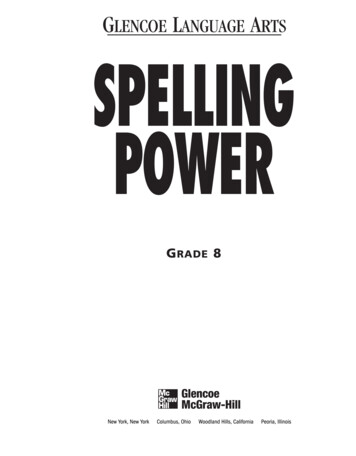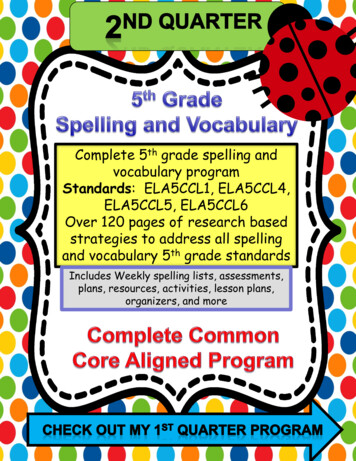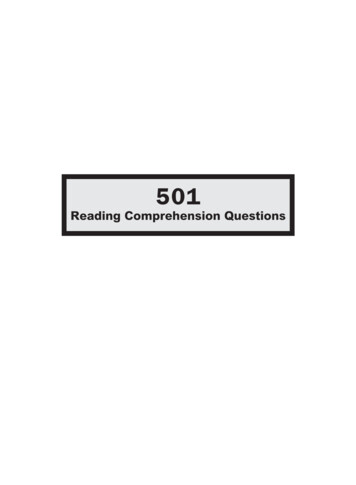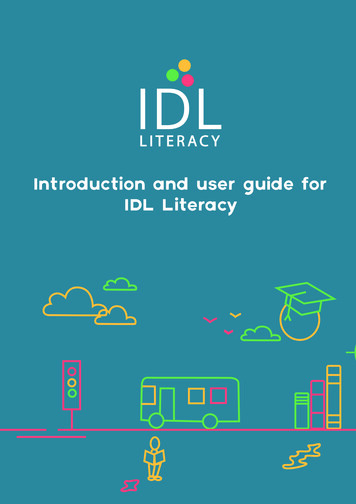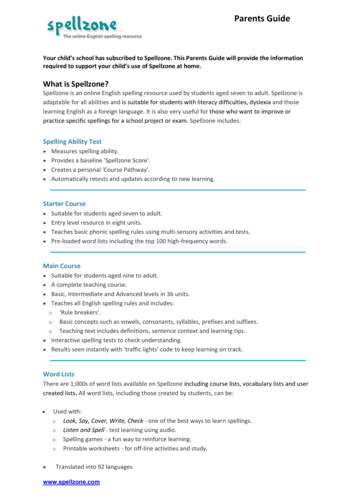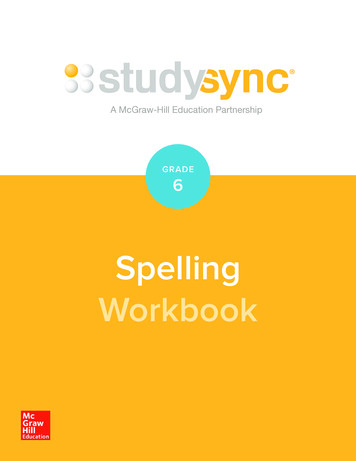
Transcription
A McGraw-Hill Education PartnershipGRADE6SpellingWorkbook
SpellingWorkbookTABLE OF CONTENTSSpelling WorkbookSpelling Workbook:Annotated Teacher’s Edition
SPELLINGPOWERG RADE 6
To the StudentThis Spelling Power workbook provides the practice you need to improve your spelling andwriting ability and to expand your vocabulary. Each spelling lesson focuses on a single spellingpattern or concept that applies to a list of words in a Word Bank. You then have severalopportunities to practice what you’ve learned: writing the words, using them in sentences,recognizing and correcting them as you proofread, and applying the spelling pattern or concept to new words that follow the same pattern. If you have trouble with an exercise, you canalways go back to the Word Bank and Key Concepts discussion, review the material, and thenreturn to the exercise.You can keep track of your own progress and achievement in spelling by using the StudentProgress Chart, which appears on page v. With your teacher’s help, you can score your workon any lesson, quiz, or test. After you know your score, use the Scoring Scale on pages vi–viito figure your percentage. Then mark your score (or percentage correct) on the StudentProgress Chart. Share your Progress Chart with your parents or guardians as your teacherdirects.Copyright McGraw-Hill EducationAll rights reserved. The contents, or parts thereof, may bereproduced in print form for non-profit educational use withMHE/Study Sync, provided such reproductions bear copyrightnotice, but may not be reproduced in any form for any otherpurpose without the prior written consent of McGraw-HillEducation, including, but not limited to, network storage ortransmission, or broadcast for distance learning.Send all inquiries to:McGraw-Hill Education2 Penn PlazaNew York, NY 10121
CONTENTSStudent Progress Chart . . . . . . . . . . . . . . . . . . . . . . . . . . . . . . . . . . . . . . . . . . . . . . . . . . . . . . . . . . . . . . . . . . . . . . vScoring Scale . . . . . . . . . . . . . . . . . . . . . . . . . . . . . . . . . . . . . . . . . . . . . . . . . . . . . . . . . . . . . . . . . . . . . . . . . . . . . viUnit 1Lesson 1: Short Vowel Spellings . . . . . . . . . . . . . . . . . . . . . . . . . . . . . . . . . . . . . . . . . . . . . . . . . . . . . . . . . . . . .Lesson 2: Long Vowel Spellings . . . . . . . . . . . . . . . . . . . . . . . . . . . . . . . . . . . . . . . . . . . . . . . . . . . . . . . . . . . . .Lesson 3: The Vowel u . . . . . . . . . . . . . . . . . . . . . . . . . . . . . . . . . . . . . . . . . . . . . . . . . . . . . . . . . . . . . . . . . . . . .Lesson 4: Double Consonants . . . . . . . . . . . . . . . . . . . . . . . . . . . . . . . . . . . . . . . . . . . . . . . . . . . . . . . . . . . . . . .Review Lessons 1–4 . . . . . . . . . . . . . . . . . . . . . . . . . . . . . . . . . . . . . . . . . . . . . . . . . . . . . . . . . . . . . . . . . . . . . . .13579Unit 2Lesson 5: The \s\ Sound with c or s . . . . . . . . . . . . . . . . . . . . . . . . . . . . . . . . . . . . . . . . . . . . . . . . . . . . . . . . . 11Lesson 6: The \k\ Sound with c, ck, ch, or qu . . . . . . . . . . . . . . . . . . . . . . . . . . . . . . . . . . . . . . . . . . . . . . . . . . 13Lesson 7: The \j\ Sound with g or j . . . . . . . . . . . . . . . . . . . . . . . . . . . . . . . . . . . . . . . . . . . . . . . . . . . . . . . . . . 15Lesson 8: Words with Silent Letters . . . . . . . . . . . . . . . . . . . . . . . . . . . . . . . . . . . . . . . . . . . . . . . . . . . . . . . . . . 17Review Lessons 5–8 . . . . . . . . . . . . . . . . . . . . . . . . . . . . . . . . . . . . . . . . . . . . . . . . . . . . . . . . . . . . . . . . . . . . . . 19Unit 3Copyright McGraw-Hill Education. Permission is granted to reproduce for classroom use.Lesson 9: Spelling the Schwa Sound . . . . . . . . . . . . . . . . . . . . . . . . . . . . . . . . . . . . . . . . . . . . . . . . . . . . . . . . . 21Lesson 10: Spelling the \ô\ Sound . . . . . . . . . . . . . . . . . . . . . . . . . . . . . . . . . . . . . . . . . . . . . . . . . . . . . . . . . . . 23Lesson 11: Spelling the \or\ Sound . . . . . . . . . . . . . . . . . . . . . . . . . . . . . . . . . . . . . . . . . . . . . . . . . . . . . . . . . . . 25Lesson 12: Doubling the Final Consonant . . . . . . . . . . . . . . . . . . . . . . . . . . . . . . . . . . . . . . . . . . . . . . . . . . . . . 27Review Lessons 9–12 . . . . . . . . . . . . . . . . . . . . . . . . . . . . . . . . . . . . . . . . . . . . . . . . . . . . . . . . . . . . . . . . . . . . . 29Unit 4Lesson 13: The \ou\ and \oi\ Sounds . . . . . . . . . . . . . . . . . . . . . . . . . . . . . . . . . . . . . . . . . . . . . . . . . . . . . . . . . 31Lesson 14: Words with ie and ei . . . . . . . . . . . . . . . . . . . . . . . . . . . . . . . . . . . . . . . . . . . . . . . . . . . . . . . . . . . . . 33Lesson 15: Dropping the Final Silent e . . . . . . . . . . . . . . . . . . . . . . . . . . . . . . . . . . . . . . . . . . . . . . . . . . . . . . . . 35Lesson 16: Keeping the Final Silent e . . . . . . . . . . . . . . . . . . . . . . . . . . . . . . . . . . . . . . . . . . . . . . . . . . . . . . . . . 37Review Lessons 13–16 . . . . . . . . . . . . . . . . . . . . . . . . . . . . . . . . . . . . . . . . . . . . . . . . . . . . . . . . . . . . . . . . . . . . . 39Unit 5Lesson 17: Keeping the Final y . . . . . . . . . . . . . . . . . . . . . . . . . . . . . . . . . . . . . . . . . . . . . . . . . . . . . . . . . . . . . . 41Lesson 18: Changing y to i . . . . . . . . . . . . . . . . . . . . . . . . . . . . . . . . . . . . . . . . . . . . . . . . . . . . . . . . . . . . . . . . . 43Lesson 19: The Suffix -ous . . . . . . . . . . . . . . . . . . . . . . . . . . . . . . . . . . . . . . . . . . . . . . . . . . . . . . . . . . . . . . . . . 45Lesson 20: The Suffix -ion . . . . . . . . . . . . . . . . . . . . . . . . . . . . . . . . . . . . . . . . . . . . . . . . . . . . . . . . . . . . . . . . . . 47Review Lessons 17–20 . . . . . . . . . . . . . . . . . . . . . . . . . . . . . . . . . . . . . . . . . . . . . . . . . . . . . . . . . . . . . . . . . . . . 49Unit 6Lesson 21: The Suffixes -ant and -ent . . . . . . . . . . . . . . . . . . . . . . . . . . . . . . . . . . . . . . . . . . . . . . . . . . . . . . . . . 51Lesson 22: Adding Prefixes . . . . . . . . . . . . . . . . . . . . . . . . . . . . . . . . . . . . . . . . . . . . . . . . . . . . . . . . . . . . . . . . . 53Lesson 23: The Prefix in- . . . . . . . . . . . . . . . . . . . . . . . . . . . . . . . . . . . . . . . . . . . . . . . . . . . . . . . . . . . . . . . . . 55Lesson 24: Nouns with Unusual Plurals . . . . . . . . . . . . . . . . . . . . . . . . . . . . . . . . . . . . . . . . . . . . . . . . . . . . . . . 57Review Lessons 21–24 . . . . . . . . . . . . . . . . . . . . . . . . . . . . . . . . . . . . . . . . . . . . . . . . . . . . . . . . . . . . . . . . . . . . 59Spelling PowerGrade 6 iii
Unit 7Lesson 25: Words with Greek and Latin Roots . . . . . . . . . . . . . . . . . . . . . . . . . . . . . . . . . . . . . . . . . . . . . . . . . . 61Lesson 26: Plurals for Nouns Ending in o . . . . . . . . . . . . . . . . . . . . . . . . . . . . . . . . . . . . . . . . . . . . . . . . . . . . . 63Lesson 27: Plurals for Nouns Ending in s, sh, ch, x . . . . . . . . . . . . . . . . . . . . . . . . . . . . . . . . . . . . . . . . . . . . . . 65Lesson 28: Plurals for Nouns Ending in f and fe . . . . . . . . . . . . . . . . . . . . . . . . . . . . . . . . . . . . . . . . . . . . . . . . 67Review Lessons 25–28 . . . . . . . . . . . . . . . . . . . . . . . . . . . . . . . . . . . . . . . . . . . . . . . . . . . . . . . . . . . . . . . . . . . . 69Unit 8Lesson 29: Compound Words . . . . . . . . . . . . . . . . . . . . . . . . . . . . . . . . . . . . . . . . . . . . . . . . . . . . . . . . . . . . . . 71Lesson 30: Words Often Confused . . . . . . . . . . . . . . . . . . . . . . . . . . . . . . . . . . . . . . . . . . . . . . . . . . . . . . . . . . . 73Lesson 31: Words Often Misspelled . . . . . . . . . . . . . . . . . . . . . . . . . . . . . . . . . . . . . . . . . . . . . . . . . . . . . . . . . . 75Lesson 32: Multi-syllable Words . . . . . . . . . . . . . . . . . . . . . . . . . . . . . . . . . . . . . . . . . . . . . . . . . . . . . . . . . . . . . 77Review Lessons 29–32 . . . . . . . . . . . . . . . . . . . . . . . . . . . . . . . . . . . . . . . . . . . . . . . . . . . . . . . . . . . . . . . . . . . . 79Copyright McGraw-Hill Education. Permission is granted to reproduce for classroom use.ivGrade 6Spelling Power
STUDENT PROGRESS CHARTFill in the chart below with your scores, using the scoring scale on the next page.Name:Copyright McGraw-Hill Education. Permission is granted to reproduce for classroom use.LessonPretestOral QuizUnit 132ReviewSpelling PowerGrade 6 v
SCORING SCALEUse this scale to find your score. Line up the number of items with the number correct. For example, if 15out of 16 items are correct, your score is 93.7 percent (see grayed area).Number of ItemsNumber 132.92.92.82.72.62.62.5Grade 917.58910111213141510088.9 1008090 10072.7 81.8 90.9 10066.7 75 83.3 91.7 10061.5 69.2 76.9 84.6 92.3 10057.1 64.3 71.4 78.5 85.7 92.8 10053.3 60 66.7 73.3 80 86.7 93.3 10050 56.2 62.5 68.7 75 81.2 87.5 93.747 52.9 58.8 64.7 70.6 76.5 82.3 88.244.4 50 55.5 61.1 66.7 72.2 77.8 83.342.1 47.4 52.6 57.9 63.1 68.4 73.7 78.9404550556065708538.1 42.8 47.6 52.3 57.1 61.9 66.7 71.436.4 40.9 45.4 50 54.5 59.1 63.6 68.134.8 39.1 43.5 47.8 52.1 56.5 60.8 65.233.3 37.5 41.7 45.8 50 54.2 58.3 62.5323640444852566030.4 34.6 38.5 42.3 46.2 50 53.8 57.729.6 33.3 37 40.7 44.4 48.1 51.9 55.628.6 32.1 35.7 39.3 42.9 46.4 50 53.627.6 31 34.5 37.9 41.4 44.8 48.3 51.726.7 30 33.3 36.7 40 43.3 46.7 5025.8 29.0 32.2 35.4 38.7 41.9 45.1 48.325 28.1 31.3 34.4 37.5 40.6 43.8 46.924.2 27.2 30.3 33 36.3 39.3 42.4 45.423.5 26.5 29.4 32.4 35.3 38.2 41.2 44.122.9 25.7 28.6 31.4 34.3 37.1 40 42.922.2 25 27.8 30.6 33.3 36.1 38.9 41.721.6 24.3 27 29.7 32.4 35.1 37.8 4021.1 23.7 26.3 28.9 31.6 34.2 36.8 39.520.5 23.1 25.6 28.2 30.8 33.3 35.9 38.520 22.5 25 27.5 30 32.5 35 658.857.155.65452.651.350Spelling PowerCopyright McGraw-Hill Education. Permission is granted to reproduce for classroom 728293031323334353637383940
Copyright McGraw-Hill Education. Permission is granted to reproduce for classroom use.Number of ItemsNumber 89.587.285Spelling Power353637383910097.2 10094.6 97.3 10092.1 94.7 97.3 10089.7 92.3 94.9 97.4 10087.5 90 92.5 95 97.540100Grade 6 vii
Name 㛭㛭 ��㛭㛭㛭㛭㛭㛭㛭㛭㛭 Class sson 1: Short Vowel SpellingsWord stingcomplexplotKey Concepts1. Short vowel sounds are often spelled with singlevowel letters.blockunrestattic2. Short vowel sounds include \a\ as in hat, \e\ as innet, \i\ as in did, \o\ as in lot, and \u\ as in cup.Spelling PracticedCopyright McGraw-Hill Education. Permission is granted to reproduce for classroom use.Put the words from the Word Bank in alphabetical order. Then circle all short vowel sounds: \a\,\e\, \i\, \o\, and \u\.1.6.2.7.3.8.4.9.5.10.Spelling in ContextdChoose the word from the Word Bank that best completes each sentence. Write the word on theline.1. Giving to charity is a(n)2. Desert lands usually have a(n)3. The4. Can I borrow your math5. “I’mSpelling Powerdeed.climate.on our car radio was annoying.to finish my homework?you to keep your promise,” said Dad.Grade 6 1
Name 㛭㛭 ��㛭㛭㛭㛭㛭㛭㛭㛭㛭 Class SSON 1 continuedProofreading PracticedAs you read the following paragraph, circle the five misspelled words. Write the correct spelling foreach circled word on the lines.My friend Nick and I were planning a plout for a mystery. I wanted to yell out my idea, but Iwas afraid I would destract him. The scene—quite vived in my mind—was very complix. Ithought both of us might benifit if I drew a picture. “What a great idea!” Nick exclaimed whenhe looked at the drawing.1.3.2.4.5.Spelling ApplicationdBelow are eight more words that reflect the Key Concepts in the lesson. Find each hidden word inthe word chain. Circle the words and then write them on the lines provided in the order in whichthey appear in the word chain. Circle the short tentCopyright McGraw-Hill Education. Permission is granted to reproduce for classroom rustrunknotimidaffodil1.5.2.6.3.7.4.8.2Grade 6Spelling Power
Name 㛭㛭 ��㛭㛭㛭㛭㛭㛭㛭㛭㛭 Class sson 2: Long Vowel SpellingsWord pleadthoroughKey ConceptsLong vowel sounds are often spelled with vowel combinations.1. The \a\ sound may be spelled ai or a e.raintape2. The \e\ sound may be spelled ea, ee, or eweekcompeteteame.3. The \i\ sound may be spelled i, igh, i e, or y.biashighkitewhy4. The \o\ sound may be spelled oa, ough, or o e.thoughnosefoamSpelling PracticedCopyright McGraw-Hill Education. Permission is granted to reproduce for classroom use.Put the words from the Word Bank in alphabetical order. Circle the letters that create the longvowel sounds.1.6.2.7.3.8.4.9.5.10.Spelling in ContextdChoose the word from the Word Bank that best completes each sentence. Write the word on theline.1. Our family does acleaning job every spring.2. I won’tthe fact that I don’t like housework.3. “Dad and I don’t want to hear one4. As usual, my little brother began to5. BySpelling Power,” said Mom.with me to help him clean his room.everybody was tired and ready for a dinner out.Grade 6 3
Name 㛭㛭 ��㛭㛭㛭㛭㛭㛭㛭㛭㛭 Class SSON 2 continuedProofreading PracticedRead the paragraph below. Find the five misspelled words and circle them. Then, on the numberedlines, write the correct spelling for each circled word.My sister Maria is kene on learning more about birds. She took an oeth to read one bookabout birds every week. The theem of one book was bird watching. The book explains whybirds migreat to warm climates. To qouat Maria: “Sometimes I wish I could fly south for thewinter too.”1.3.2.4.5.Spelling ApplicationdListed below are ten more words that reflect the Key Concepts you have learned. Read eachcrossword puzzle clue. Then write the correct word from the word list in the puzzle squares.baitlameboastrestyleDown2. style again3. mixture for baking5. playground chute6. dark blue green color4Grade 6doughslide13greedteal24578691011Spelling PowerCopyright McGraw-Hill Education. Permission is granted to reproduce for classroom use.Across1. special alphabet for the blind4. breathes deeply7. brag8. unable to walk10. food for fish11. selfishnessBraillesighs
Name 㛭㛭 ��㛭㛭㛭㛭㛭㛭㛭㛭㛭 Class sson 3: The Vowel uWord ualroutinecruisevacuumKey ConceptThe vowel u is used less frequently than a, e, i, or o. Try to visualize these words as you learn to spell them.Here’s a trick to help you remember vacuum: It is the only common English word that has two u’s in a row.Spelling PracticedCopyright McGraw-Hill Education. Permission is granted to reproduce for classroom use.Write the words from the Word Bank in alphabetical order.1.6.2.7.3.8.4.9.5.10.Spelling in ContextdUse context clues to determine which word from the Word Bank best completes each sentence.Write the word on the line.1. The Declaration of Independence is a great historic2. An important campaign3. In our city, ais how to lower taxes.cannot be out after 10:00 P.M. without an adult.4. A pet owner can be fined if his or her dog becomes a5. My parents left for aSpelling Power.to neighbors.in the Caribbean.Grade 6 5
Name 㛭㛭 ��㛭㛭㛭㛭㛭㛭㛭㛭㛭 Class SSON 3 continuedProofreading PracticedRead the letter. Find the five misspelled words and circle them. Then write the correct spelling foreach circled word on the lines that follow.Dear Mayor Gibson,We are writing to express our gratitood for your support of our school Science Fair. We arehappy that you took time from your rootine activities to attend! Our favorite display showedhow a vakume cleaner works. We thought watching the machine work was more interestingthan reading the manool. All of us younite in thanking you!Yours truly,The students at Deergrove Middle School1.3.2.4.5.Spelling ful1. helpful, suitable,2. chase, follow,3. mean, unkind,4. give, donate,5. many, countless,6. forgive, apologize,6Grade 6Spelling PowerCopyright McGraw-Hill Education. Permission is granted to reproduce for classroom use.Below are six more words that reflect the Key Concept you have learned. Write the word whosemeaning fits each set of terms.
Name 㛭㛭 ��㛭㛭㛭㛭㛭㛭㛭㛭㛭 Class sson 4: Double ConsonantsWord cidentsummarizevillainappropriateKey Concepts1. Double consonants often follow short vowelsounds.yellowchubby2. Double consonants usually represent a singleunit of sound.flattenskipping3. Sometimes double consonants represent two units ofsound.succeed (hard and soft c)fishhook (sh blend and h)Spelling PracticedCopyright McGraw-Hill Education. Permission is granted to reproduce for classroom use.Put the words from the Word Bank in alphabetical order. Circle the double consonants in eachword. Then write 2 or 3 to describe the Key Concept that applies to that word.1.2.2.4.3.6.4.8.5.10.Spelling in ContextdChoose the word from the Word Bank that best completes each sentence. Write the word on theline.1. Every student gets a(n)2. We were asked to3. I don’t like listening to4. The police captured thefor the school election.the story in our own words.that might hurt others.as he fled from the crime.5. During a snowstorm, Mom drives slowly to avoid a(n)Spelling Power.Grade 6 7
Name 㛭㛭 ��㛭㛭㛭㛭㛭㛭㛭㛭㛭 Class SSON 4 continuedProofreading PracticedRead the ad that follows. Find and circle the five misspelled words. Then write the correctly spelledwords on the lines below.Come to Our Mammith Jacket Sale!We have hundreds of jackets to sell. No stock is being witheld for next year! Our jackets areescential for any wardrobe. They are aproppriate for casual or formal events. Choose a jacketfor your next special ockasion.1.3.2.4.5.Spelling ApplicationdBelow are ten more words with double consonants. Find each word from the list and circle it in thepuzzle. Then list the words on the lines. Write a 3 next to any words that are examples of KeyConcept uddenCopyright McGraw-Hill Education. Permission is granted to reproduce for classroom use.additionknickknackst k n i c k k n a c k sn o l r e w o l l a t ue e l z z i s a s b n cmi g a t h s ma b e cmk o i a s i r f a t eo e d l i a d o t g u sc d a f n s u d d e n sa n y t a e t u l l o p1.6.2.7.3.8.4.9.5.10.8Grade 6Spelling Power
Name 㛭㛭 ��㛭㛭㛭㛭㛭㛭㛭㛭㛭 Class it 1 ReviewLessons 1– itecomplexmammothsummarizevividChoose the word from the word list above that best completes each sentence.1.lands have a shortage of rainfall.2. Camels areto people living in desert areas.3. The camel's ability to carry heavy loads is a4. Ato the desert dwellers.camel owners have is that their animals often have bad tempers.5. You can’tthat those hard workers have a right to feel crabby sometimes.Copyright McGraw-Hill Education. Permission is granted to reproduce for classroom use.6. During a camel’s daily, stopping for food is not always possible.7. Theirdigestive system helps them go days without eating.8. Providing food is not anthat camel owners have to deal with daily.9. Desert sand can be a10. To, but camels are lucky enough to have three eyelids., camels are well-suited for desert life.Use a word from the word list above to define the following phrases. Write the word on the lineprovided.11. main idea of a paper12. young person13. move or travel to another location14. join together15. instructive book16. omitting nothing17. strikingly bright18. election form19. huge20. scratchy electrical soundSpelling PowerGrade 6 9
Name 㛭㛭 ��㛭㛭㛭㛭㛭㛭㛭㛭㛭 Class oofreading ApplicationLessons 1– 4As you read the story, find the twenty misspelled words and circle them. Then write the correctspelling for each circled word on the lines that 20.7.14.10Grade 6Spelling PowerCopyright McGraw-Hill Education. Permission is granted to reproduce for classroom use.Detective Shelly Sherlock was kean on solving mysteries. Today’s problem was jewelry missing from Countess Lily’s hotel room. First Shelly did a thorogh search for clues. She found animportant documint in the countess’s room. “The vilain might have left fingerprints on this,”Shelly guessed.Shelly worked until twylight completing her rutine search around the hotel. Quite by acident,she ran into a couple carrying some cleaning supplies. “What brings you here?” she asked.“We’re part of the cleaning crew for a special ocasion,” they replied.“Ah! the plat thickens!” thought Shelly. Trousting her intuition, she pretended that the couplewas innocent. To destract them, she offered them some gum and then tossed the wrapper onthe carpet. When they didn’t pick it up, Shelly guessed they were not working for the hotel.“I’ve heard some gosip about burglars. Have you seen anything strange?” As they looked ateach other, Shelly knocked over their vacum cleaner. The contents spilled out. There were thecountess’s jewels!“I pleed with you not to force us to talk!” the man begged. “We took an ooth to keep ourboss’s secret. It’s not apropriate to talk about the boss.”“It’s my duty to call the police,” Shelly said. “I have never witheld evidence.”Later the countess showed her greatitude by inviting the detective to visit her in Paris. Toquoet Shelly: “What an unselfush person!”
Name 㛭㛭 ��㛭㛭㛭㛭㛭㛭㛭㛭㛭 Class sson 5: The \s\ Sound with c or sWord entlicensevicinitybicycleKey ConceptThe \s\ sound can be spelled with an s or with a c that is followed by an e, i, or ancycycleSpelling PracticedChoose a word from the Word Bank to match each pronunciation. Write the word on the line.Copyright McGraw-Hill Education. Permission is granted to reproduce for classroom use.Example:fanⴕ sƒfancy1. prªⴕ v‰ sƒ6. fanⴕ t‰ sƒ2. lªⴕ s‰ns7. inⴕ s‰ d‰nt3. k‰n sªsⴕ8. rƒⴕ s‰nt4. bªⴕ s‰ k‰l9. sitⴕ ‰ z‰n5. vi sinⴕ ‰ tƒ10. k‰n sentⴕSpelling in ContextdChoose the word from the Word Bank that best completes each sentence. Write the word on theline.1. If your report is too wordy, you can make it more2. If youto do something, you agree to do it.3. If an event is4. If your story is a5. If you enjoy being alone, you like yourSpelling Power., it did not happen long ago., it can be called fiction.Grade 6 11
Name 㛭㛭 ��㛭㛭㛭㛭㛭㛭㛭㛭㛭 Class SSON 5 continuedProofreading PracticedAs you read the following news item, circle the five misspelled words. Write the correct spelling foreach circled word on the lines below.Youngster Helps Senior SitizenMrs. Sylvia Yancy, who lives in the visinity of the police station, called to tell us about arecent insident in her neighborhood. Ricky Rice was riding his bisycle past her house just aftergetting his bike lisence at the station. As Ricky rode by, Mrs. Yancy tripped and was unable toget up. Ricky rode back to the station to ask for help. One police officer remarked, “He certainlyis a sensible kid.”1.3.2.4.5.Spelling ApplicationdListed below are eight additional words that reflect the Key Concept in the lesson. Write each newword next to the word or phrase that defines it. Circle the letters that make the \s\ sound in eachword.circulatesenatorcourtesyspecifyCopyright McGraw-Hill Education. Permission is granted to reproduce for classroom use.centimeterdecidecyclonespicy1. peppery2. politeness3. describe in detail4. distribute5. tornado6. legislator7. unit of measurement8. make up mind12Grade 6Spelling Power
Name 㛭㛭 ��㛭㛭㛭㛭㛭㛭㛭㛭㛭 Class sson 6: The \k\ Sound with c, ck, ch, or quWord rchitectrecklessfocusbouquetKey ConceptThe \k\ sound can be spelled with a c, ck, ch, or qu. Try to visualize these words as you learn to spell utiqueSpelling PracticedWrite the words from the Word Bank in alphabetical order. Circle the letters that represent the \k\sound.Copyright McGraw-Hill Education. Permission is granted to reproduce for classroom use.1.2.3.4.5.6.7.8.9.10.Spelling in ContextdChoose the word from the Word Bank that best completes each sentence. Write the word on theline.1. Our school’s2. We are a littleSpelling Powersings for all holiday programs.when we haven’t had enough time to rehearse.Grade 6 13
Name 㛭㛭 ��㛭㛭㛭㛭㛭㛭㛭㛭㛭 Class SSON 6 continued3. The director says, “Relax andon the audience.”4. She is encouraging me to pursue ain music.5. To show our appreciation, we presented her with aof roses.Proofreading PracticedAs you read the paragraph below, find and circle the five misspelled words. Then write the correctspelling for each circled word on the lines that follow.I. M. Pei is a famous arckitekt. His building designs are meticulous drawings, not just reclesssketches. He often uses a special technicue, combining shapes such as cubes and cylinders toachieve a dramatick effect. Mr. Pei used his design principles in creating the John F. KennedyLibrary in order to to reflect the former president’s strong caracter.1.3.2.4.5.Spelling Applicationdatticchemistⵧ4. close group of friends6. one kind of scientist14Grade 6educatenecklaceⵧⵧ3. top floor of some houses5. puddingcustardⵧ1. teach2. pendantcliqueⵧⵧSpelling PowerCopyright McGraw-Hill Education. Permission is granted to reproduce for classroom use.Listed below are six more words that contain the \k\ sound. Fill in the blanks with the word thatbest fits each meaning. After you have filled in the blanks, note that the letters in the squares forma word. Use that word to complete the sentence: “I am.”
Name 㛭㛭 ��㛭㛭㛭㛭㛭㛭㛭㛭㛭 Class sson 7: The \j\ Sound with g or jWord majorityenergyjealousKey ConceptThe \j\ sound can be spelled with a j or with a g that is followed by an e, i, or angiblestingygymSpelling PracticedWrite each word from the
To the Student This Spelling Power workbook provides the practice you need to improve your spelling and writing ability and to expand your vocabulary. Each spelling lesson focuses on a single spelling pattern o
